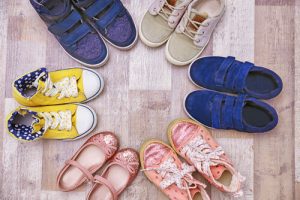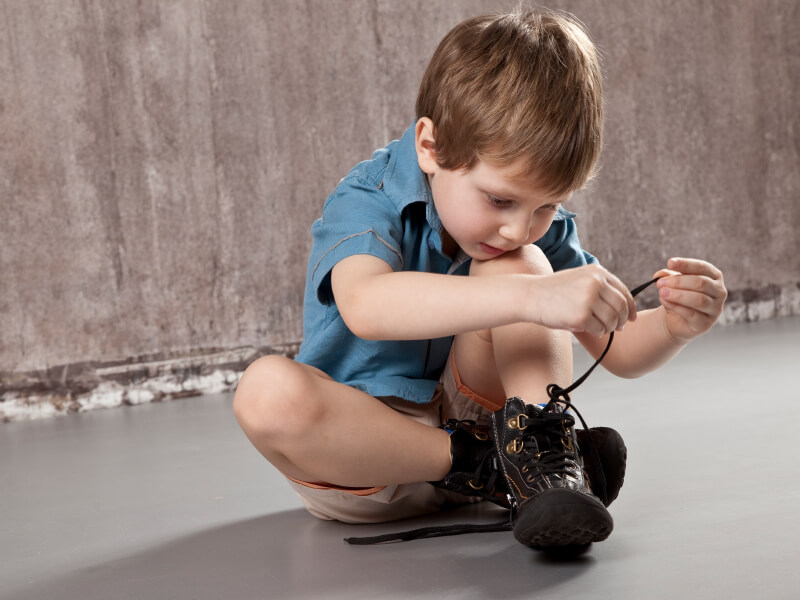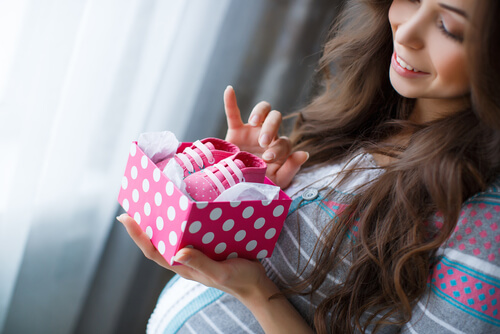Choosing Your Children's Shoes Carefully

In this article we’ll share with you all you need to know about choosing your children’s shoes.
Your child’s feet are fragile and you should pay special attention when it comes to choosing their shoes.
Choosing the right shoes for your child is important. However, it’s sometimes difficult to find the right model among all of the products that can be found in stores.
Keep in mind that the ideal shoes for your children must meet the criteria of comfort, flexibility and lightness. There are also some important characteristics to consider that vary according to a child’s age.
A good pair of shoes can help little ones adopt good posture and this will have a positive impact on their long-term physical development.
Characteristics that should be taken into account when choosing children’s shoes
Here’s a list of important characteristics that you should keep in mind when choosing the proper footwear for your child:
1. The material
This is one of the most important factors since it affects the comfort and durability of the shoe. Leather is the best material since it’s breathable, flexible, insulating and very comfortable.

If you decide on leather shoes, make sure that leather is present both on the outside and inside of the shoe.
If leather makes up the inner lining of the shoe, it guarantees comfort and breathability. This is true even in the summer!
Contrary to popular belief, a barefoot child in a leather shoe sweats much less than in a synthetic one.
2. Velcro or shoelaces?
Velcro has the advantage of being very easy to use. All you have to do is put on the shoes and that’s it!
It’s so simple, however, that it can become a disadvantage because the child will be able to take them off easily.
Velcro also loosens easily and therefore it cannot guarantee proper foot support, especially during the first years after a child learns how to walk.
When it comes to shoelaces, they won’t be easily taken off by your child unlike Velcro. Shoelaces ensure good foot support, yet you should be careful not to tighten them too much in order to prevent compressing their feet.
The disadvantages when it comes to shoelaces is that they can be hard to put on if the child is irritable. It’s also difficult to teach children how to tie them on their own.
“There is always a moment in childhood when the door opens and lets in the future.”
3. What size?
Shoes that are too small compress the child’s feet. On the other hand, shoes that are too big can also cause inconveniences.
The shoelaces will have to be tied very tightly in order to make sure the shoes fit their feet. Shoes that are too big can cause discomfort while walking.
Here’s the ideal technique when it comes to choosing the correct shoe size for your child:
- Remove the false sole from the inside of the shoe. Place the shoe on the ground and ask your child to put their foot inside it. Keep in mind that their toes shouldn’t extend beyond the shoe’s width.
- There should be a space of approximately 1cm between the child’s longest toe and the tip of the shoe to allow a little space for growth.
4. Low tops or high tops?
Low shoes aren’t ideal for small children. Their feet are better suited for higher shoes. At first a baby’s feet are flat since they haven’t developed arches yet.
However, once the arches have been formed (around 4 years) you can use both low-top and high-top shoes.
What about babies? How can you choose the right shoes for them to take their first steps in?
During the first months after birth, shoes are more about satisfying the mother’s wishes with small sets of accessories for the baby. Shoes at this age play a protective role against the cold and possible harm.

When the baby begins to walk, their first shoe’s main function is to facilitate their first attempts to get up and walk alone.
It’s preferable to choose shoes that are suitable for the child, offering support that promotes the proper development of their feet.
Regardless of the child’s age, you should always select shoes that are the right size, have a light heel and allow for approximately 1cm between the tip of their toes and the end of the shoes to allow for growth.
You’ll have to change your children’s shoes frequently as they grow.
In conclusion, we hope that our advice on how to pick the right shoes for your children has helped you. From now on you’ll have the knowledge to make the right choice.
In this article we’ll share with you all you need to know about choosing your children’s shoes.
Your child’s feet are fragile and you should pay special attention when it comes to choosing their shoes.
Choosing the right shoes for your child is important. However, it’s sometimes difficult to find the right model among all of the products that can be found in stores.
Keep in mind that the ideal shoes for your children must meet the criteria of comfort, flexibility and lightness. There are also some important characteristics to consider that vary according to a child’s age.
A good pair of shoes can help little ones adopt good posture and this will have a positive impact on their long-term physical development.
Characteristics that should be taken into account when choosing children’s shoes
Here’s a list of important characteristics that you should keep in mind when choosing the proper footwear for your child:
1. The material
This is one of the most important factors since it affects the comfort and durability of the shoe. Leather is the best material since it’s breathable, flexible, insulating and very comfortable.

If you decide on leather shoes, make sure that leather is present both on the outside and inside of the shoe.
If leather makes up the inner lining of the shoe, it guarantees comfort and breathability. This is true even in the summer!
Contrary to popular belief, a barefoot child in a leather shoe sweats much less than in a synthetic one.
2. Velcro or shoelaces?
Velcro has the advantage of being very easy to use. All you have to do is put on the shoes and that’s it!
It’s so simple, however, that it can become a disadvantage because the child will be able to take them off easily.
Velcro also loosens easily and therefore it cannot guarantee proper foot support, especially during the first years after a child learns how to walk.
When it comes to shoelaces, they won’t be easily taken off by your child unlike Velcro. Shoelaces ensure good foot support, yet you should be careful not to tighten them too much in order to prevent compressing their feet.
The disadvantages when it comes to shoelaces is that they can be hard to put on if the child is irritable. It’s also difficult to teach children how to tie them on their own.
“There is always a moment in childhood when the door opens and lets in the future.”
3. What size?
Shoes that are too small compress the child’s feet. On the other hand, shoes that are too big can also cause inconveniences.
The shoelaces will have to be tied very tightly in order to make sure the shoes fit their feet. Shoes that are too big can cause discomfort while walking.
Here’s the ideal technique when it comes to choosing the correct shoe size for your child:
- Remove the false sole from the inside of the shoe. Place the shoe on the ground and ask your child to put their foot inside it. Keep in mind that their toes shouldn’t extend beyond the shoe’s width.
- There should be a space of approximately 1cm between the child’s longest toe and the tip of the shoe to allow a little space for growth.
4. Low tops or high tops?
Low shoes aren’t ideal for small children. Their feet are better suited for higher shoes. At first a baby’s feet are flat since they haven’t developed arches yet.
However, once the arches have been formed (around 4 years) you can use both low-top and high-top shoes.
What about babies? How can you choose the right shoes for them to take their first steps in?
During the first months after birth, shoes are more about satisfying the mother’s wishes with small sets of accessories for the baby. Shoes at this age play a protective role against the cold and possible harm.

When the baby begins to walk, their first shoe’s main function is to facilitate their first attempts to get up and walk alone.
It’s preferable to choose shoes that are suitable for the child, offering support that promotes the proper development of their feet.
Regardless of the child’s age, you should always select shoes that are the right size, have a light heel and allow for approximately 1cm between the tip of their toes and the end of the shoes to allow for growth.
You’ll have to change your children’s shoes frequently as they grow.
In conclusion, we hope that our advice on how to pick the right shoes for your children has helped you. From now on you’ll have the knowledge to make the right choice.
This text is provided for informational purposes only and does not replace consultation with a professional. If in doubt, consult your specialist.








